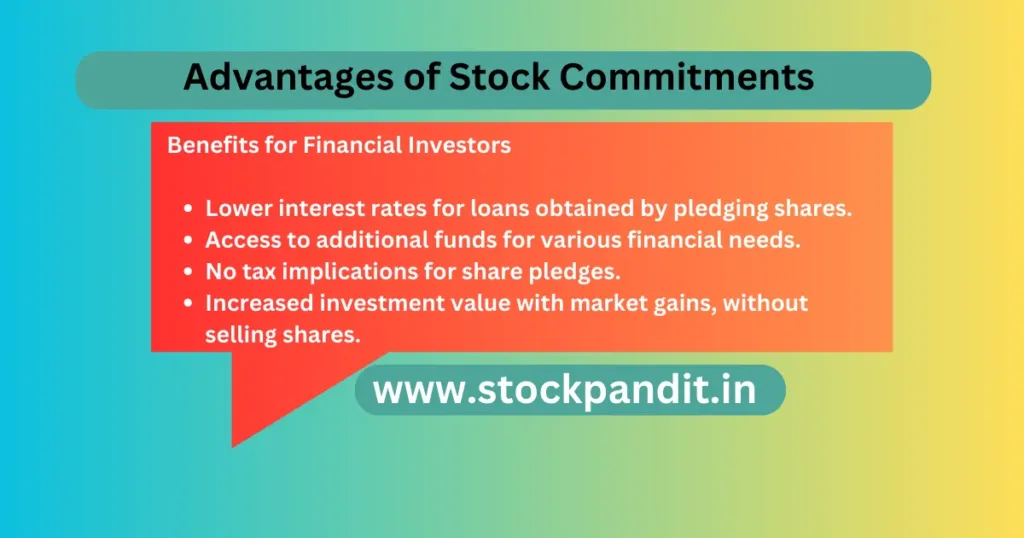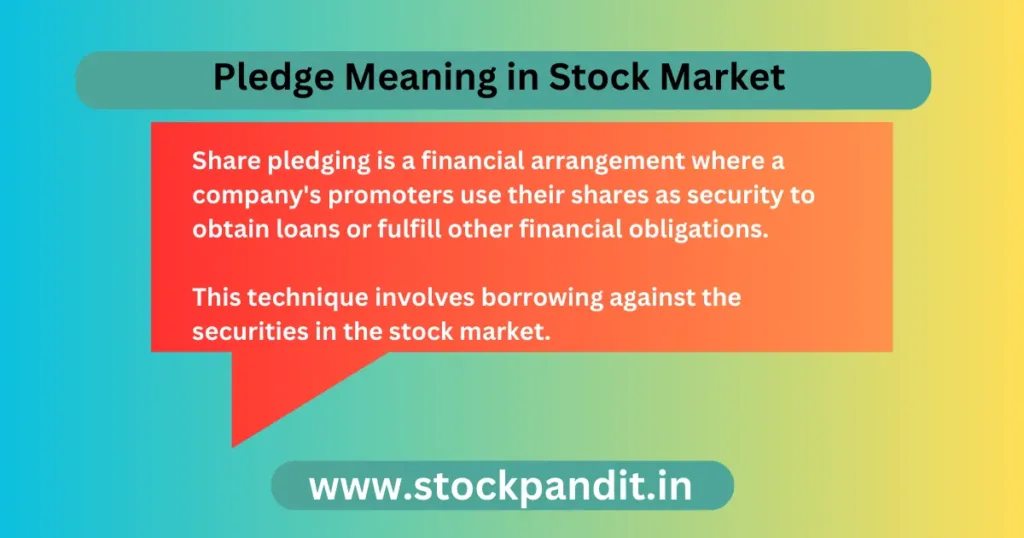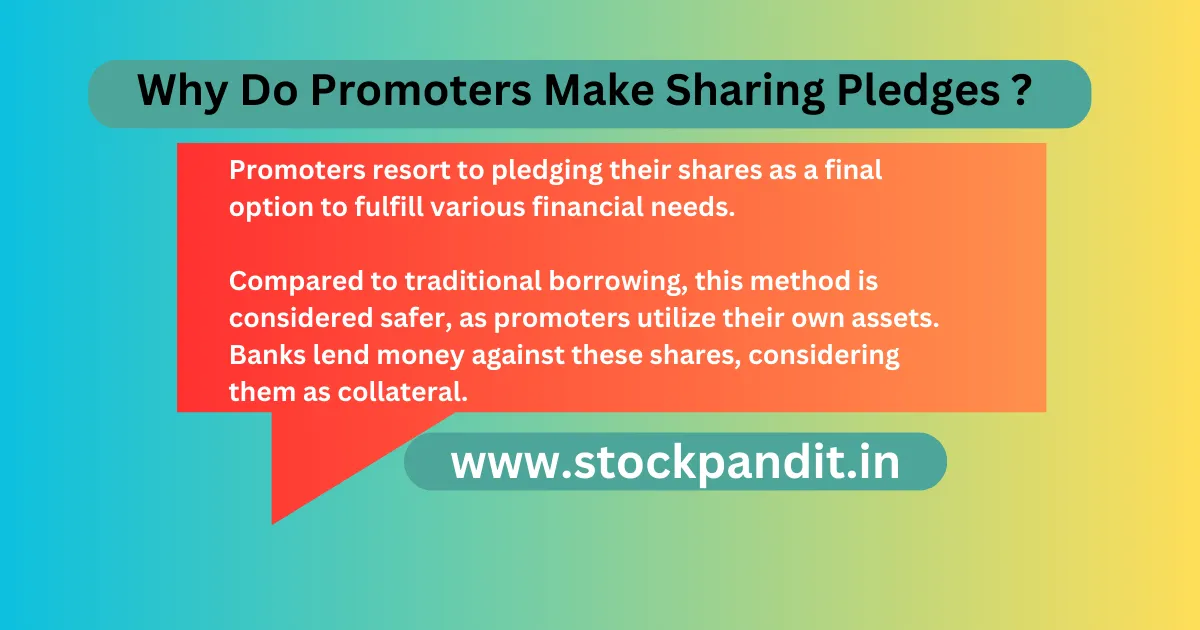This blog explores the Pledge Meaning in Stock Market, its operational aspects, benefits, drawbacks, and essential considerations for shareholders and businesses.
In the dynamic world of the stock market, various financial strategies are employed to secure capital for businesses. One such technique that has gained popularity is the pledging of shares.
What Is the Pledge Meaning in Stock Market ?
Definition and Objective
Share pledging is a financial arrangement where a company’s promoters use their shares as security to obtain loans or fulfill other financial obligations.
This technique involves borrowing against the securities in the stock market.
Typically used by businesses with significant investor holdings, share pledging allows the borrower to retain ownership of the shares while meeting financial needs.
Value of Collateral and Variations in the Market
The collateral value is contingent on market changes, and promoters must maintain a minimum collateral value as specified in the agreement.
If the market value of the pledged shares falls below the agreed amount, the borrower must either provide more shares or make a cash payment to cover the shortfall.
Failure to do so may result in the lender selling the shares on the open market, diminishing the stock’s value and the promoters’ stake.
How Does the Process of Sharing Pledging Work ?
Market dynamics and financial needs
Investors often pledge their shares as collateral to meet financial requirements, especially high-value share owners. This practice allows them to seize trading opportunities without having sufficient cash on hand, preventing potential losses.
Why Do Promoters Make Sharing Pledges ?
Requirements for Cash and Security

A Haircut: What Is It ?
Method for Reducing Risk
When pledging shares, a haircut margin safeguards the lender’s interests by defining the gap between the shares’ true value and their collateral value.
This margin acts as a safety net in case of market volatility. If the shares’ value sharply declines, failure to maintain the haircut percentage could lead to substantial losses for the lender.
Advantages of Stock Commitments

Market Dynamics and Safety
Pledging shares may not pose issues in a bullish market; however, in a bear market, investors face risks as the collateral’s value fluctuates with stock prices. If the market declines, promoters may need to repay the lender with cash or more shares.
The open sale of pledged shares by lenders can significantly impact stock prices, potentially leading to a loss of company value and changes in shareholding patterns.
You May Also Like:
What Is Expiry Date In Indian Stock Market
In the stock market, what is MTM?
What is CE and PE in Stock Market ?
What Is ASM And GSM 6 Stages In Stock Market
Conclusion
Utilizing shares as collateral for loans, known as share pledge, is a common practice among promoters to invest or raise funds for their organizations.
While share pledging offers advantages, investors and promoters must carefully plan and execute strategies to navigate potential risks and uncertainties in the market.
What is share pledging in the stock market?
Share pledging is a financial arrangement where promoters offer their shares as security to obtain loans or fulfill financial obligations.
This involves borrowing against the value of the shares in the stock market.
How does the share pledging process operate?
Investors pledge their shares as collateral to meet financial needs. The pledged shares allow them to seize trading opportunities without having sufficient cash on hand, preventing potential losses.
Why do promoters give share pledges?
Promoters pledge shares as a final resort to meet various financial needs. Compared to traditional borrowing, pledging shares is considered safer, as promoters utilize their own assets, and banks lend money against them as collateral.
What is a haircut in share pledging?
A haircut is a margin that safeguards the lender’s interests in share pledging.
It represents the difference between the true value of the shares and their collateral value, acting as a safety net against market volatility.
What are the benefits of pledging shares?
Benefits include lower interest rates for loans obtained by pledging shares, access to additional funds for various financial needs, no tax implications, and increased investment value with market gains without selling shares.
Is pledging shares risky for investors?
Pledging shares may not pose issues in a bullish market, but in a bear market, investors face risks as the collateral’s value fluctuates with stock prices. Market conditions can impact the viability of share pledging.
What happens if the market value of pledged shares falls below the agreed amount?
If the market value of pledged shares falls below the agreed amount, the borrower must provide more shares or make a cash payment to cover the shortfall.
Failure to do so may lead to the lender selling the shares on the open market.
Can promoters lose their stock if they fail to maintain collateral value?
Yes, if promoters fail to maintain the minimum collateral value, lenders may sell the pledged shares as collateral to recoup their money. This could result in a loss of the promoters’ stock.
Are there tax implications for share pledges?
No, there are generally no tax implications for share pledges. This is advantageous for borrowers as they can access funds without incurring additional tax burdens.
How does the open sale of pledged shares affect stock prices?
The open sale of pledged shares by lenders can significantly impact stock prices. It may lead to a loss of company value and changes in shareholding patterns, potentially affecting voting rights.
Can investors continue to receive dividends on pledged shares?
Yes, investors can continue to receive dividends on pledged shares. Dividend income is one of the additional benefits that accrue to borrowers and remains unaffected by the pledging process.
How can investors mitigate risks associated with share pledging?
Investors can mitigate risks by carefully monitoring market conditions, having contingency plans for market downturns, and executing smart strategies.
Planning ahead and staying informed are crucial in navigating potential uncertainties.






